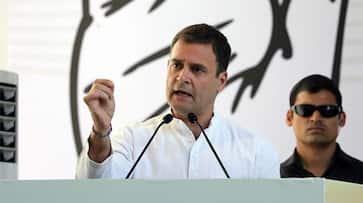MyNation did a social media sentiments analysis along with Cybersecurity NGO Root64 foundation using Opini8 (www.algo8.ai), an AI-powered tool that gives in-depth insight on public perception and reaches on social media platforms to analyse #NYAY
New Delhi: Rahul Gandhi’s latest weapon to take on BJP for the Lok Sabha election is Nyay (Nyuntam Aay Yojana), a minimum income guarantee scheme which seems to have gathered momentum on social media. Days after announcing the scheme the hashtag #Nyay has picked up, but the pattern indicates a possibility of social media warriors engaging in causing an inflation in the use of the word.
The Congress party has promised to roll out Nyuntam Aay Yojana or NYAY to provide cash support of Rs 6,000 a month to about five crore of the most impoverished families in the country if it is voted to power.
The social media analysis of the word Nyay shows that around 45 % of people on social media have positively tweeted about it, while close to 25 % have firmly rejected the policy and have criticised the concept of Nyay on social media. 30% of the people are neutral and didn’t have any opinion about it but have casually shared the related content. Critics of the scheme claim that it will cause a substantial financial burden on the country’s balance sheet.
MyNation did the social media sentiments analysis along with Cybersecurity NGO Root64 foundation using Opini8 (www.algo8.ai), an AI-powered tool that gives in-depth insight on public perception and reaches on social media platforms. However, these trends are based on data captured from Twitter between March 29-April7 and do not reflect the actual feeling.

“I don’t see a very strong rejection on the social media with almost 45% of positive tweets and a significant 30% of neutral tweets. However, it’s interesting to see that the momentum slowly picked up on 4th April with more than 15,000 positive tweets,” said Amit Dubey founder of Root64 foundation.


Scanning the pattern of Nyay also reflects that not everything is fine here as there are very few original posts and the number of retweets have been abnormally high indicating that social media marketing machinery is working to propel the content online.
“In any such twitter analysis, retweet counts are an important number. On one side, retweet numbers show the excitement and support for the topic while on other side, retweets can be done easily through bots,” Dubey said.
He explained that a large number of retweets as compared to the original tweets creates a doubt that such numbers might have been achieved by pushing this through bots or social media marketing tools.
Interestingly, an original number of tweets and the number of replies are almost the same number. The sentiments wave has been created through retweets, which resulted in the word trending.

What goes in favour of NYAY scheme is the support it has gathered at a geographical level. A maximum number of tweets have been gathered from Ahmedabad followed by Gurgaon, Jaipur, Bhubaneshwar, Lucknow, Chandigarh.
It indicates that most of the supporters are from metro cities and clustered across the educated belt. This goes against the believes that NYAY might be supported mostly by the uneducated or lower middle class.
“This can be interpreted in two ways. This is in line with the communist thought process, and that’s why it got direct support from a particular type of educated class, or this could be partially a derived attempt through some social marketing companies mostly located in metros and tier 1 and two cities,” Dubey explained.

Last Updated Apr 17, 2019, 12:04 PM IST









![Salman Khan sets stage on fire for Anant Ambani, Radhika Merchant pre-wedding festivities [WATCH] ATG](https://static-gi.asianetnews.com/images/01hr1hh8y86gvb4kbqgnyhc0w0/whatsapp-image-2024-03-03-at-12-24-37-pm_100x60xt.jpg)
![Pregnant Deepika Padukone dances with Ranveer Singh at Anant Ambani, Radhika Merchant pre-wedding bash [WATCH] ATG](https://static-gi.asianetnews.com/images/01hr1ffyd3nzqzgm6ba0k87vr8/whatsapp-image-2024-03-03-at-11-45-35-am_100x60xt.jpg)


